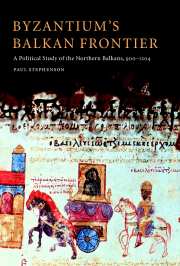Book contents
- Frontmatter
- Contents
- List of maps and figures
- Preface
- A note on citation and transliteration
- List of abbreviations
- Introduction
- 1 Bulgaria and beyond: the Northern Balkans (c.900–963)
- 2 The Byzantine occupation of Bulgaria (963–1025)
- 3 Northern nomads (1025–1100)
- 4 Southern Slavs (1025–1100)
- 5 The rise of the west, I: Normans and Crusaders (1081–1118)
- 6 The rise of the west, II: Hungarians and Venetians (1100–1143)
- 7 Manuel I Comnenus confronts the West (1143–1156)
- 8 Advancing the frontier: the annexation of Sirmium and Dalmatia (1156–1180)
- 9 Casting off the ‘Byzantine Yoke’ (1180–1204)
- Conclusions
- Bibliography
- Index
5 - The rise of the west, I: Normans and Crusaders (1081–1118)
Published online by Cambridge University Press: 25 August 2009
- Frontmatter
- Contents
- List of maps and figures
- Preface
- A note on citation and transliteration
- List of abbreviations
- Introduction
- 1 Bulgaria and beyond: the Northern Balkans (c.900–963)
- 2 The Byzantine occupation of Bulgaria (963–1025)
- 3 Northern nomads (1025–1100)
- 4 Southern Slavs (1025–1100)
- 5 The rise of the west, I: Normans and Crusaders (1081–1118)
- 6 The rise of the west, II: Hungarians and Venetians (1100–1143)
- 7 Manuel I Comnenus confronts the West (1143–1156)
- 8 Advancing the frontier: the annexation of Sirmium and Dalmatia (1156–1180)
- 9 Casting off the ‘Byzantine Yoke’ (1180–1204)
- Conclusions
- Bibliography
- Index
Summary
When Alexius Comnenus came to power in 1081 the empire's frontier to the north had been breached by the Pechenegs. Eventually, as we have seen, he achieved a hard-fought victory against the nomads which secured the imperial position at the lower Danube for almost a century. However, even as the tumult to the north was calmed, several new threats emerged beyond the empire's western borders which would severely test imperial arrangements in the lands of the southern Slavs and the coastal lands of Dalmatia and Dyrrachium. The first major threat was posed by the Normans.
THE NORMANS IN SOUTHERN ITALY, 1059–1081
At the council of Melfi in 1059 Pope Nicholas II invested Robert Guiscard, the leader of a group of Normans who had settled in Italy, with legitimate title to Apulia and Sicily. These regions hitherto had recognized Byzantine suzerainty. After 1051 imperial interests in Apulia had been served through a local magnate named Argyrus, who had been raised to the rank of magistros and given the title doux of Italy. However, his appointment had led indirectly to the Papal-Norman entente, for it provoked the patriarch of Constantinople, Michael Cerularius, to consider the problems of the Orthodox church in Italy. Argyrus was a Latin Christian who had clashed with the patriarch when he served as patron of the Latin churches in Constantinople between 1045 and 1051.
- Type
- Chapter
- Information
- Byzantium's Balkan FrontierA Political Study of the Northern Balkans, 900–1204, pp. 156 - 186Publisher: Cambridge University PressPrint publication year: 2000



